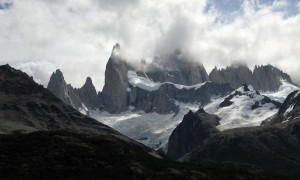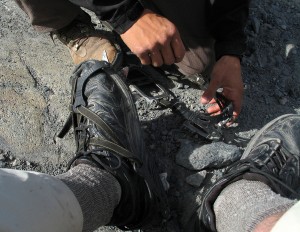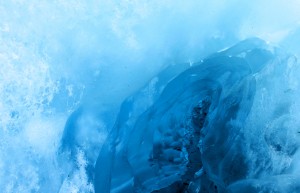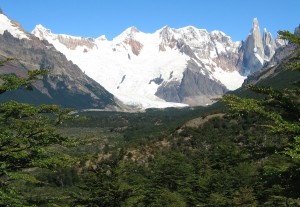We spent four nights in El Chaltén. It is a frontier town, established only about 25 years ago as a government move to establish an Argentine presence in this remote part of Argentina near the Chilean border. It has become a haven for trekking and backpackers. It is rare to see someone walking in the street without a backpack or arms full of camping gear. Hostels abound. Many trekkers spend several nights camping then come to El Chaltén for one night in a hostel so they can catch an early morning bus out of town.
It can be expensive if you stay in town. But it has trail heads for many treks to remote areas with magnificent views of some of the most rugged ranges in the world. The signature peaks are hidden in the older part of town, but they become visible with only a short walk to the newer north end on a clear day. We were told that it is rare to see FitzRoy and Torre cloud-free, and this was true on our hike the first day to Lago Capri.
As clouds swept past the peaks, we could see Torre but not FitzRoy or vice versa, never both. It was like a strip tease and she never took it all off.
The next day, we had our favorite activity so far: trekking on a glacier. We went by bus and boat to the glacier front for pictures then to the rock near the Viedma Glacier. (Click for more pictures).
Our guides helped us fit crampons and we click-clacked across the rock and onto the glacial ice. We looked down into crevasses, walked into large cracks, saw the wonderful blue hues of the internal ice, straddled pools of melt water all done safely under the watchful eyes of the three guides for 15 people.
Before leaving the glacier, the guides served a shot of Bailey’s chilled with fresh glacial ice.
The next day, we did an 8 1/2 hour hike to the spectacular panorama at Laguna Torre. The day was bright and clear – it was a rare cloudless day and the peaks were absolutely clear. The walk started uphill but soon leveled out with modest ups and downs the rest of the way.
Part way in there is an overlook with a clear view up the valley to Cerro Torre and the glaciers it towers over. It is a goal for hard-core climbers. The trail continues through a forest of lenga trees. The harsh climate causes these trees to grow into tortured, twisted shapes. There was an area that had burned a while ago and white bleached skeletons dominate the landscape.
Laguna Torre is a small, milky glacial lake surrounded by a rocky, gravely moraine. We sat on the moraine for nearly an hour admiring the sharp spires of Cerro Torre. It is truly among the most spectacular sights in Patagonia.
The hike back brought different views, now looking down the valley. We followed the swift flowing river that drains Laguna Torre then back up and over a saddle and down the steep slopes and back into the town of El Chaltén. We were tired but the day-long walk was well worth the effort.
We spent one more night in our least favorite accommodation of our trip, the Rancho Grande hostel. We had bunks in a four-bunk room with different roommates each of our three nights there. That was fine and expected. What was not fine was the kitchen, which is advertised as available to all who stay there. It was ill-equipped and small with flies everywhere. It had three small refrigerators – NONE of them worked and they all stunk of spoiled food, most of which had to be thrown out. We cannot recommend staying at the Rancho Grande. There are many new hotels and hostels being built all over town. Be sure to check some of them out before committing to the Rancho Grande, and follow the guidebooks’ advice to reserve early if possible!







